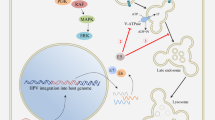Abstract
At present, no treatments exist that effectively target and eliminate papillomaviruses (PVs) from infected cells or prevent its replication. We are employing a strategy to prevent virus replication in PV-infected cells through the conditional expression of the herpes simplex virus type 1 thymidine kinase (TK) gene. Expression of TK in this system is expected to be triggered by a homologous recombination event between the endogenous PV genome and a nonexpressing TK gene cassette. Recombination between these two DNAs is expected to change the nonexpressing cassette into a form that expresses TK. Various constructs were generated to express the TK in the above manner. Transfection of cell lines with a TK nonexpressing plasmid did not result in TK production due to alternative splicing and polyadenylation site selection. However, cotransfection of cell lines with PV plasmids along with the above TK construct containing short segments of PV sequences resulted in a recombination event that led to TK expression as shown by Northern and Western blot analyses. We also developed a TK expression cassette utilizing an adeno-associated virus (AAV) vector. Delivery of the cassette by AAV to PV-infected cells resulted in TK expression, and ganciclovir treatment resulted in efficient killing of these cells.
This is a preview of subscription content, access via your institution
Access options
Subscribe to this journal
Receive 12 print issues and online access
$259.00 per year
only $21.58 per issue
Buy this article
- Purchase on Springer Link
- Instant access to full article PDF
Prices may be subject to local taxes which are calculated during checkout






Similar content being viewed by others
References
Dell G, Gaston K . Contributions in the domain of cancer research: review of human papillomaviruses and their role in cervical cancer. Cell Mol Life Sci 2001; 58: 1923–1942.
Stubenrauch F, Laimins LA . Human papillomaviruses: active and latent phases. Cancer Biol 1999; 9: 379–386.
Frauke Fehrmann F, Laimonis LA . Human papillomaviruses: targeting differentiating epithelial cells for malignant transformation. Oncogene 2003; 22: 5201–5207.
zur Hausen H . Papillomaviruses and cancer: from basic studies to clinical application. Nat Rev Cancer 2002; 2: 342–350.
Ayers D et al. Homologous recombination between autonomously replicating plasmids in mammalian cells. Genetics 1985; 111: 375–388.
Thyagarajan B, McCormick-Graham M, Romero DP, Campbell C . Characterization of homologous DNA recombination activity in normal and immortal mammalian cells. Nucleic Acids Res 1996; 24: 4084–4091.
Kitamura Y, Yoshikura H, Kobayashi I . Homologous recombination in a mammalian plasmid. Mol Gen Genet 1990; 222: 185–191.
Salomon B et al. A truncated herpes simplex virus thymidine kinase phosphorylates thymidine and nucleoside analogs and does not cause sterility in transgenic mice. Mol Cell Biol 1995; 15: 5322–5328.
Edwards-Gilbert G, Veraldi KL, Milcarek C . Alternative poly(A) site selection in complex transcription units: means to an end? Nucleic Acids Res 1997; 25: 2547–2561.
Batt DB, Luo Y, Carmichael GG . Polyadenylation and transcription termination in gene constructs containing multiple tandem polyadenylation signals. Nucleic Acids Res 1994; 22: 2811–2816.
Maxwell IH, Harrison GS, Wood WM, Maxwell F . A DNA cassette containing a trimerized SV40 polyadenylation signal which efficiently blocks spurious plasmid-initiated transcription. BioTechniques 1989; 7: 276–280.
Rubnitz J, Subramani S . The minimum amount of homology required for homologous recombination in mammalian cells. Mol Cell Biol 1984; 4: 2253–2258.
McBride AA, Howley PM . Bovine papillomavirus with a mutation in the E2 serine 301 phosphorylation site replicates at a high copy number. J Virol 1991; 65: 6528–6534.
Hansen J, Qing K, Srivastava A . Adeno-associated virus type 2-mediated gene transfer: altered endocytic processing enhances transduction efficiency in murine fibroblasts. J Virol 2001; 75: 4080–4090.
Demone RM, Cole CN . Patterns of polyadenylation site selection in gene constructs containing multiple polyadenylation signals. Mol Cell Biol 1988; 8: 4829–4839.
Cooke C, Hans H, Alwine JC . Utilization of splicing elements and polyadenylation signal elements in the coupling of polyadenylation and last-intron removal. Mol Cell Biol 1999; 19: 4971–4979.
Kuo HC, Nasim FH, Grabowski PJ . Control of alternative splicing by the differential binding of U1 small nuclear ribonucleoprotein particle. Science 1991; 251: 1045–1050.
Xiao X, Li J, Samulski RJ . Production of high-titer adeno-associated virus vectors in the absence of helper adenovirus. J Virol 1998; 72: 2224–2232.
Venturoli S et al. Detection of adeno-associated virus DNA in female genital samples by PCR-ELISA. J Med Virol 2001; 64: 577.
Sethi N, Palefsky J . Treatment of human papillomavirus (HPV) type 16-infected cells using herpes simplex virus type I thymidine kinase-mediated gene therapy transcriptionally regulated by the HPV E2 protein. Hum Gene Ther 2003; 14: 45–57.
Zolotukhin S et al. Recombinant adeno-associated virus purification using novel methods improves infectious titer and yield. Gene Therapy 1999; 6: 973–985.
Sambrook J, Fritsch EF, Maniatis T . Molecular Cloning: A Laboratory Manual. Cold Spring Harbor Laboratory Press: Cold Spring Harbor, 1989.
Mizuno M, Yoshida J, Colosi P, Kurtzman G . Adeno-associated virus vector containing the herpes simplex virus thymidine kinase gene causes complete regression of intracerebrally implanted human gliomas in mice, in conjunction with ganciclovir administration. Jpn J Cancer Res 1998; 89: 76–80.
Fukui T et al. Suicide gene therapy for human oral squamous cell carcinoma cell lines with adeno-associated virus vector. Oral Oncol 2001; 37: 211–215.
Acknowledgements
A Carson was supported by a Graduate Fellowship from the National Science Foundation.
Author information
Authors and Affiliations
Rights and permissions
About this article
Cite this article
Carson, A., Wang, Z., Xiao, X. et al. A DNA recombination-based approach to eliminate papillomavirus infection. Gene Ther 12, 534–540 (2005). https://doi.org/10.1038/sj.gt.3302447
Received:
Accepted:
Published:
Issue Date:
DOI: https://doi.org/10.1038/sj.gt.3302447



